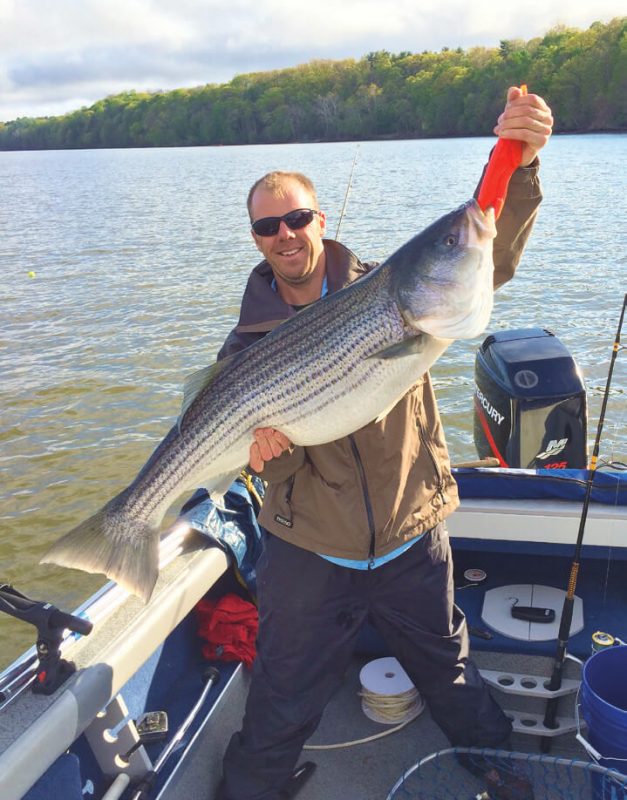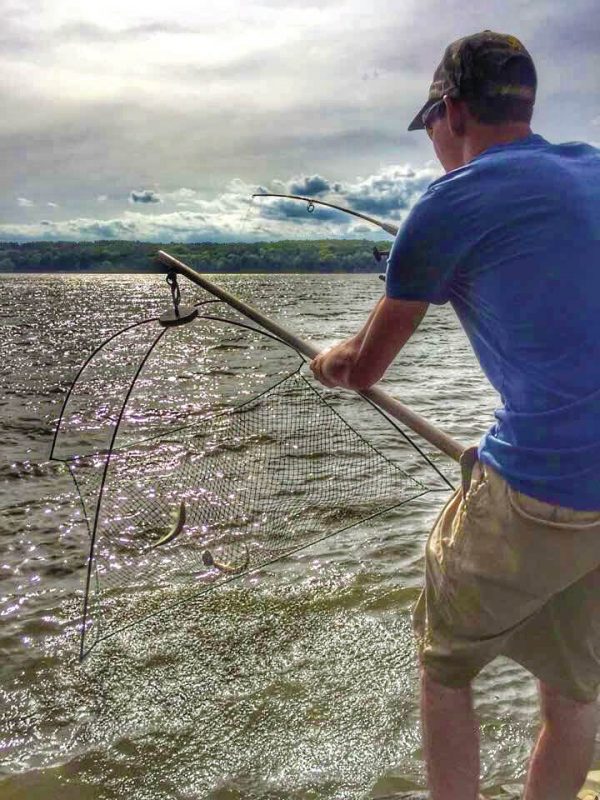New York’s Hudson River could hardly be considered pristine on its lower end. That doesn’t seem to bother the striped bass.
Each spring, through the river’s mouth at bustling New York Harbor, a massive spawning migration of Atlantic stripers pushes up the Lower Hudson some 150 miles to the Federal Dam at Troy, N.Y. Upstream egress is halted at this lock and dam just north of Albany, and striped bass are likely to show up anywhere downstream of the dam when water temps reach the 60s in this stretch of tidally influenced river.

“They move in big schools,” Maneri said. “Some days they’re there and you can catch them; other days they’re not. You gotta stay on the reports. They’re running the whole river, so you could travel to where the fish are or wait until they’re where you are.”
A smaller schoolie striped bass shows up first. These fish are the most numerous and generally measure less than 30 inches in length with weights in the low teens and lighter. They come with the spawning alewives, which are baitfish locals call herring. Schoolie stripers could remain in the river for a couple months some years, and there’s a resident year-round population of these smaller fish. Maneri said the big cows show up in numbers for only a week or two each season. They are always on the move, and connecting with them can lead to unbelievable action with big fish measuring past the 40-inch mark with weights heavier than 30 pounds.
The largest fish to come from this run up the Hudson was caught in May 2014. It weighed 60 pounds and was caught from the Newburgh Bay area, more than 50 miles upstream from New York City.
Although it is possible to catch big stripers on swimbaits or streamer flies when they are feeding actively on herring spawning on shallow sand flats, fishing bait is generally more productive. Visibility is minimal in the Hudson’s dingy waters. So enticing all of a fish’s senses with fresh bait is the best way to draw their attention. The best bait is herring pulled right out of the river, either live or chunked.
Maneri and most locals use a scap net to catch herring up to 6 or 7 inches in length. A scap net is essentially a 4’x4’ dip net. Since the herring are schooling, they will follow a soft plastic swimbait right up to the net where they are captured.
Maneri also prefers to fish his herring off the bottom when heavy tidal currents are moving. He uses medium and medium-heavy rods with baitrunner-style reels that allow fish to run with the bait on the free spool before the angler strikes to set the hook and engage the drag. He employs the main line of the 30-pound braid with a 1 ½-foot leader of 15- to 20-pound fluorocarbon. A 7/0 Gamakatsu Octopus is his hook of choice, and the herring should be hooked through the mouth. The whole rig is kept down with a 2- or 3-ounce slide swivel teardrop sinker.
He said that stripers don’t really relate to any kind of structure on their spawning run, so choosing a location to drop baits is more about determining where baitfish might be funneled when the stripers show up. Drop-offs or channels are good locations, and sometimes stripers will herd herring up against the shore.
Obviously, a boat gives anglers the ability to move around and seek out fish. But fishing from shore is also productive. With fish moving so much, it’s only a matter of waiting for them to show up around your bait if they are in the area. When he fishes from the shore, Maneri uses rod holders made from PVC pipe and rebar. They are an important tool that can be staked into the bank or wedged into rip-rap to free up the angler while waiting for a bite.
And the bite can be a tricky thing. Maneri said these stripers have a knack for spitting the bait before or on the hook set. There are all kinds of theories on how long to let the fish run before setting the hook. He said they might get 15 runs on a good day and only get a solid hook set in five fish. Or, those 15 runs might produce 10 fish. It’s a matter of luck and getting a feel for the technique.
One thing is for sure; when the hook sets solid and the drag is engaged, a big striped bass in heavy current is a formidable opponent.
“Those bigger fish, they’ll be running and the drag is just screaming off the reel,” Maneri said. “The rod will be bent right down to the water. And when you’re fishing off the shore, it’s pretty rough footing. They’ll pull you over if you’re not careful.”
Dave Maneri is a team member of Catskill Outdoors. Look them up on Facebook.
